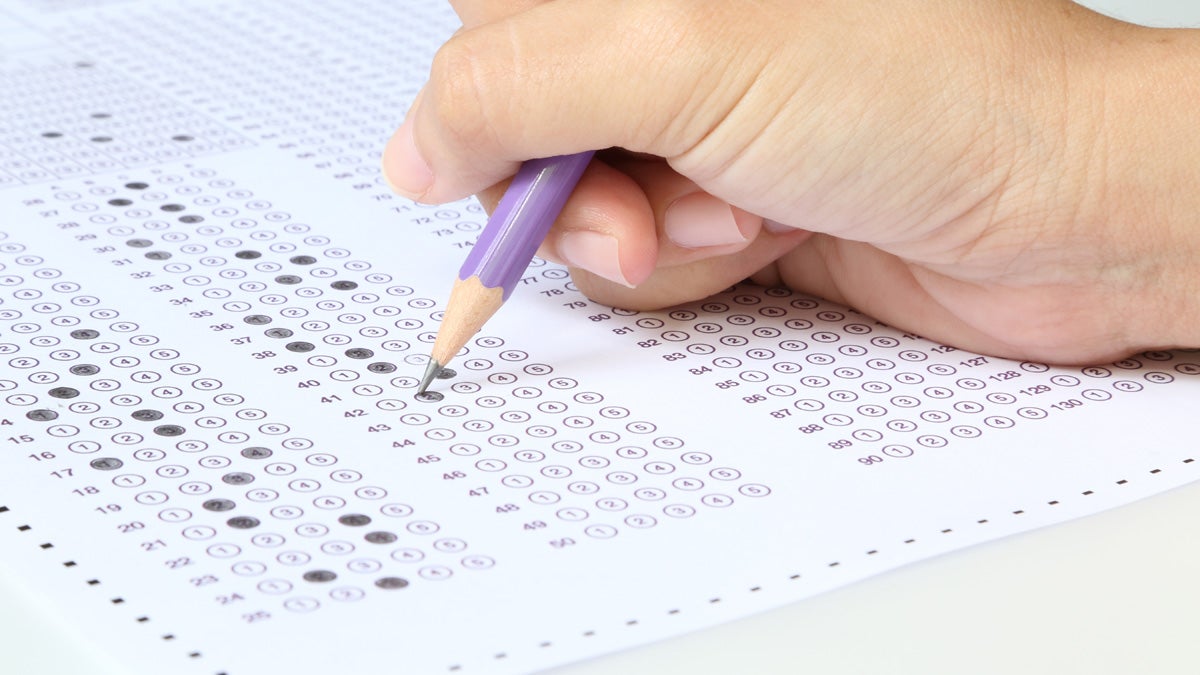Pa. says 2015 standardized test scores dropped precipitously because of added rigor
Listen Photo via ShutterStock) " title="shutterstock_156272558" width="1" height="1"/>
Photo via ShutterStock) " title="shutterstock_156272558" width="1" height="1"/>
(Photo via ShutterStock)
And it marks a fourth straight year of test score declines.
UPDATE:
The number of Pennsylvania students who scored “proficient” or “advanced” on state standardized tests in 2014-15 has fallen precipitously compared with the previous year.
And it marks a fourth straight year of test score declines.
The Pennsylvania Department of Education confirms the drop, but will not provide specifics – citing the need to finalize data.
But a chart available on the department’s website provides a clearer picture of preliminary results.
Analysis shows that the proficiency rates in grades three through eight dropped on average by 35.4 percentage points in math and 9.4 percentage points in English language arts on the Pennsylvania System of School Assessment (PSSA) exam.
Department officials attribute the declines to the increased rigor of the state standardized tests.
This past school year was the first in which every question aligned with the Pennsylvania Core Standards – which are similar, but not identical to the Common Core standards adopted in other states.
Last week, based on the new standards, the Pennsylvania Board of Education voted to readjust its expectations for how the more difficult tests would be scored – setting new cutoffs for “advanced,” “proficient,” “basic” and “below basic.” This process is known as setting the “cut scores.”
With the changes, the state has made it substantially more difficult for students to earn a proficient designation on its tests.
The table below shows a comparison of the percentage of students scoring “basic” or “below basic” on PSSA exams in 2013-14 and 2014-15.
|
Results of the state Keystone exam, taken by high school students, have not yet been released.
The possible ramifications of large drops in student proficiency on the PSSA are still being hashed out.
Meanwhile, the department said 2014-15 should be considered the new baseline for year-to-year comparisons.
“It isn’t useful to compare these 2015 student results directly to past results, because the tests are different,” said department press secretary Nicole Reigelman. “Student performance hasn’t changed, but the test has changed considerably in some grades.”
In October, under the direction of former Gov. Tom Corbett, department spokesman Tim Eller said scores from 2013-14 should be considered the “new baseline.”
In 2012, then-state Education Secretary Ron Tomalis said that year’s results were the first Pennsylvanians could trust after years of systemic cheating.
In recent years, lawmakers at the state and federal level have tied several high-stakes accountability measures to student performance on standardized tests.
The state’s school performance profile system assigns high-stakes grades to schools based 90 percent on test scores.
The state’s new teacher evaluation system judges teachers, in part, based on student test scores – accounting for school-wide student performance, as well as the growth of students enrolled in a teacher’s class.
‘Almost perfect recipe to attack teachers’
So how will declining scores based on more rigorous tests affect educators?
Despite saying that it isn’t “useful” to compare this year’s scores with past results, the department said those comparisons will be inherent in the the state’s evaluation of schools and teachers.
“The scores on the 2015 PSSAs will have an impact on teacher effectiveness ratings and the school performance profile,” said Reigelman.
The Pennsylvania State Educators Association, the state’s largest teachers union, said that will undoubtedly feed misperception.
“You are going to see huge outcry, and I can certainly envision a scenario where teachers are very unjustly attacked for this process,” said Chris Clayton, assistant director for education services at PSEA. “You have essentially moved the target for teachers to get their students to, and then you raised the bar with these cut scores, all in combination with funding cuts.”
A bill that would tie teacher furloughs to the new teacher evaluation system has passed the state House of Representatives.
Another bill that would push back the state’s standardized-test graduation requirement until 2019 has passed the Senate.
In concert, if advanced, these bills would give students less motivation to perform well on tests while holding teachers more accountable for student results.
“It’s almost like a perfect recipe to attack teachers in many ways,” said Clayton.
PDE executive deputy secretary David Volkman doesn’t believe the changes “will have a real negative impact on teacher evaluations.”
Fifteeen percent of a teacher’s evaluation is comprised of a three year rolling average of student growth on state tests. That part of the evaluation, though, doesn’t go into effect until 2015-16. By 2016-17, results of the old, easier test will have been phased out.
Teachable moment?
Adam Schott, the former executive director of the Pennsylvania Board of Education, said reaction to the declining scores must be nuanced.
“These are more demanding standards and very ambitious cut scores. To the extent that the public and policymakers have that context, and understand that there’s more work to do, more investments to make, that could offer a teachable moment,” said Schott, who now acts as director of policy research for Research for Action.
“On the other hand, there have been very concerted efforts to undermine confidence in public schools, specifically efforts that use standardized test results to label schools as ‘failing,'” he said. “I think we all need to be more mindful to police that kind of rhetoric.”
Schott headed the board when it adopted Common Core standards in 2010. (These were later amended to become the Pennsylvania Core standards in 2013.)
The department, now under the leadership of Democratic Gov. Tom Wolf, has de-emphasized the importance of standardized tests when discussing the matter. Official policies and systems, though, remain unchanged.
“There is a heavy weight placed on PSSA scores, and there needs to be a discussion on how to holistically assess student performance by looking at measures beyond standardized tests,” said Reigelman.
In a letter sent to superintendents last week, Education Secretary Pedro Rivera anticipated backlash at the community level.
“We understand there are secondary impacts of these scores, and we’re committed to helping you – the state’s educators, school administrators, and stakeholders – in improving student achievement and communicating the new assessments and the results in your communities,” Rivera wrote.
PDE also cast blame for the score declines on tightened school budgets in recent years.
“Whenever there is a change in standards, districts need to transition curriculum, purchase new books, and undertake other changes,” said Reigelman. “The fact that resources were reduced over the past several years did make the transition in standards more tedious.”
How are cut scores set?
Whenever there are significant changes to state standards, the state board of education commissions a panel of educators to readjust the cut scores.
From June 9 to 12, 58 Pennsylvania teachers conferred to come up with recommendations for what skills it should take for students to meet each ability benchmark. This body determines test questions that act as “bookmarks” for each designation.
Then on June 19, a much smaller review committee (including two teachers) met to revise the larger body’s work. This committee looks at the actual test results to see how recommendations would affect the amount of students meeting proficiency targets.
In this year’s case, the review committee revised the recommended cut scores in five places in the math tests. The department said these changes were neither politically motivated, nor statistically significant.
Those recommendations were approved by the board of education on July 9.
The board of education is distinct from the department of education. It is made up of 22 gubernatorial appointees who serve six-year terms.
WHYY is your source for fact-based, in-depth journalism and information. As a nonprofit organization, we rely on financial support from readers like you. Please give today.





